Stories
Reports, reviews, interviews, essays, and opinions about music and its connection to business and society.
«I have been sober for four years now. It was a significant process»
Camiel Meiresonne and his band, Son Mieux, are on their way up. Ahead of their concert in Zurich, we spoke to the band's mastermind about disco, sad moments, and his sobriety.
«We met before, right,» Camiel Meiresonne asks on the other end of a video call from his hotel room in Budapest. «It was backstage at a picknick table, right?» The moment, the frontman of Dutch indie-pop sensation Son Mieux recalls, lays way in the past:
It was their first show abroad, at a small open-air in Switzerland in 2016.
«I do remember that gig. We had a little event for our crew and management about a month ago. We had a pub quiz, and there was a question about our first-ever gig abroad.»
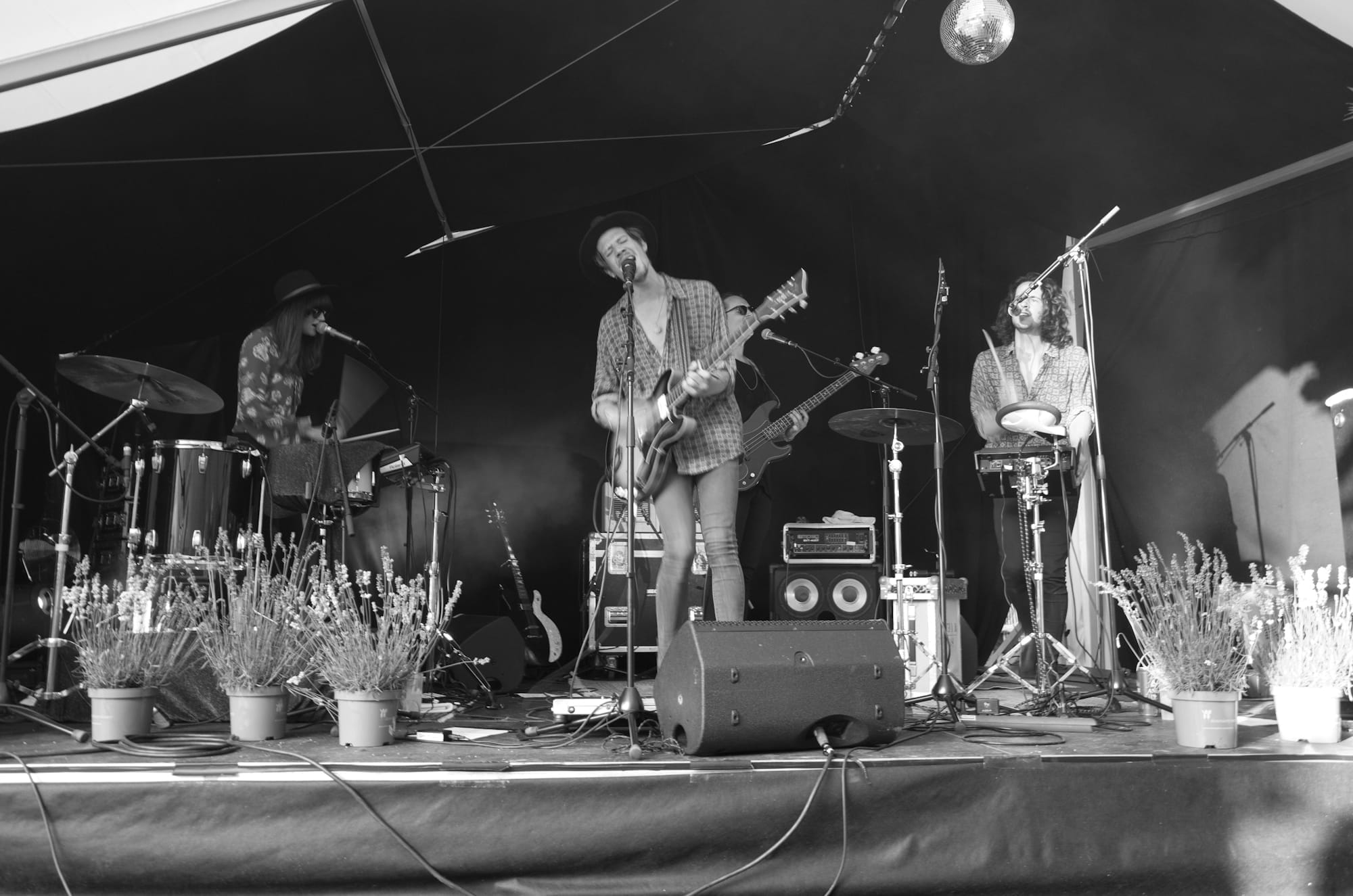
Today, almost eight years later, Son Mieux are in a completely different place. In their home country, they sell out huge shows. Their second studio album, The Mustard Seed, was awarded an «Edison», the Dutch equivalent to the Grammys. Shortly after, they released the single Multicolor, which remained the number one spot for most airplay for eight weeks.
Son Mieux currently tours through Europe with concerts in major cities—also in Zurich's Exil club on February 22. Time to catch up before the show.
It has been a while since we last spoke, and a lot has happened for you and the band. Looking back, what are the most significant aspects?
The main thing is that we've actually truly become a band. Back in 2016, everything felt like a solo project. We had the live group, but I was writing and recording the songs. The records we've made and the shows we've played for the last couple of years we have been making as a group where everybody found its place.
Collaborating as a group also has evolved the music. Where things, in the beginning, were more acoustic stuff with electronics around it, now the sound is formed around the people that make up the band. We've been taking our time to find the right sound, the right stories, and the right people. If I look back now, we were not rushed to make it. Step by step, we found the place where we felt comfortable but still excited.
You already touched on the evolving sound. You have developed a certain vintage vibe, a lot of disco feeling. What is it about this sound that fascinates you?
We always look for ways to give our songs a twist. Most of the songs that we write are still folk songs. They are even a bit sad if you play them on an acoustic guitar or a piano. Their themes are not always only positive.
I Switched From Spotify To Apple Music. Was It Worth It?
Spotify is the obvious choice for anyone looking for a music streaming service. However, the company often annoys me despite their undeniably great product. So I tried to switch it up.
About two years ago, I wrote a piece about Spotify and the power of their product regarding design, where I compared the streaming primus with Apple Music. The conclusion then was easy: Spotify has simply the better experience.
However great the product might be, I still dislike the company. The decisions they have made in recent times are at odds with my values as a music enthusiast. Their payout model is abysmal. And yet, as someone writing about music and curating playlists, there is no way around the green goblin.
Also, as a music writer, I already pay for many music subscriptions: Spotify Duo (for my personal and Negative White’s account), Apple Music, and YouTube Music (bundled in with YouTube Premium). They amount to about $60 monthly—not an insignificant amount.
Having this arsenal of streaming services at hand, I once again started the journey of switching my primary service: Goodbye Spotify, hello Apple Music. It has been about a month, and here is what I learned.
Exploring The Fascination For Moyka
Since her debut single in 2019, the author has repeatedly written about Norwegian pop artist Moyka but has never succeeded in scratching more than the surface.
Almost exactly five years ago, Moyka entered my life and playlists and never really left. In March 2019, the then-21-year-old Monika Engeseth released her debut single, Colder. After that, the Norwegian artist became a frequent subject in Negative White's reporting: eight times I featured one of her tracks in Weekly5—more than any other artists.
But in all those years, I have never been able to accurately capture my fascination for Moyka in words. Rereading the short reviews, they only scratch on the outer layers, unable to crack the code and bust open the door to reveal the answer.
The blame may fall onto the music itself: Moyka produces pop music, and that is precisely the opposite of what I usually love. However, between these addictively catchy melodies, there is a pinch of melancholy, even sadness, and a cinematic quality to her songs, coated with a Nordic frost.

Zurich, 8th of February. The day has finally come: It is Moyka's first concert in Switzerland. Marking the end of her first European tour, she would bring her sophomore album, Movies, Cars & Heartbreak (2023), to the stage.
After writing concert reviews for years, I still struggle, even dislike them—especially if the show was great. I believe people have a lifetime quota for superlatives in writing, and I have already used mine. You try to capture the vibe, and sometimes you succeed. But that is more often pure luck. A writer's happy accident.
And there is this other danger lurking: Anticipation. For months, I have been looking forward to the show; for years, I listened to the songs. What if the concert crumbles under the weight of imaginary expectations?
But I had a mission that night: Find the deeper roots of my fascination for Moyka.



There is something inherently unique about small-scale concerts. Around 30 people found their way to X-Tra Musikcafé that night—a relatively small crowd barely filling half of the already tiny venue. But each and every one wanted to be there.
The show started. Already Gone. Already goosebumps.
The evening defied all challenges: The sound, light, and setlist were exceptional. It lasted an hour, but somehow, Moyka's meandering voice took us into a different dimension where time did not exist. Framed by two men on synthesisers and drums, she delivered a mesmerising, otherworldly vocal performance.
However, it was in between the songs that the pieces finally fell into place. «This evening is a space for big emotions,» Moyka told the audience.
Understanding Moyka means appreciating the duality of music and its inspiration. The Nordic crystalline sound of her ethereal pop creates a reserved distance. These angelic hymns seem larger-than-life, reducing one's existence to a tiny spec of dust in eternity. But underneath this cathedral-sized sound, undiluted emotion builds the foundation and pulls you back into the most profound definition of being human.

Once this connection bridges the gap, it all makes sense: We are capable of fiery love, despairing sadness, and profound gratitude. Moyka sounds large because our feelings are overwhelming. Her music becomes a catalyst for recognising and accepting these moments of emotional excessiveness.
I know you're holding your guard up
And I know that you think you're bad luck
But darling, that's not who you are to me
—Moyka - Rear View
Moyka led by example: There was no filter, no stage persona clouding her authenticity. She not only accepted but invited and embraced vulnerability. She spread pure joy. When two people in the audience kissed, her eyes lit up so bright they could convert the devil to a saint.
And we followed. We danced in tender escalation, closed our eyes and dreamed, revelled in delight, escaped reality and received catharsis.



Keep Dancing Inc. – A Taste of Possibility
French trio Keep Dancing Inc.'s second album, «A Taste of Possibilty», features ten promising songs but fails to create sonic cohesiveness.
What is an album worth in the age of streaming and playlist domination? The Parisian trio Keep Dancing Inc. released their sophomore album—A Taste of Possibility—and it might provide one potential answer to that question.
Louis de Marliave, Joseph Signoret, and Gabrielle Cressaux initially found each other through a shared love for acts like «LCD Soundsystem, Depeche Mode, and Palma Violets,» as de Marliave states in the album’s press release. Adding in a constant fascination for synthesizers, the Beatles’ harmonies, and electronic formations like New Order and Hot Chip, the trio’s sound is easily deciphered.
Entering the public spotlight with their debut album Embrace in 2020, the dance-pop band followed with an array of singles—as it is best practice today—culminating in the EP Can’ttrio’s Get You Out Of My Mind that features four out of the ten tracks on A Taste of Possibility.

Recorded during the pandemic’s height, the process differed from before: «We were working with a more stripped-back sound of just a synth, guitar and drums and found that we were much tighter as a band,» states bassist Joseph Signoret.
But it wasn’t just the songwriting process or the live recording that challenged Keep Dancing Inc. The trio embarked on entirely self-producing the record. The band’s collaborative spirit meant that everyone could pitch in: «Everyone brings ideas to the table that we work on together,» explains Signoret further in the press release.
Keep Shifting Inc.
All this information sets the backdrop for listening to A Taste of Possibility. And it seems the album’s title is already engraved as a prophecy for what to expect. Keep Dancing Inc., so the perception, took the possibilities quite literally and explored their sound in all directions.
It starts with 96, an eclectic instrumental track featuring heavy guitar work, fuzzy bass lines, and playful synth melodies, pulling back the curtain of what Keep Dancing Inc.’s sound entails. There’s just enough jam session flavour and drive to create something intriguing.
From there, we arrive at A Taste of Possibility, the album’s namesake song. To say that it sounds different from the opener would be a gross understatement. We are greeted by summer-warm pop, refined with a pinch of funk. It is an almost unbearably happy sound.
And the sound keeps shifting colours from there on out like a hyperactive chameleon: Murders Mourns Again, criticizing Western hypocrisy, is a fast-paced rock sound, housing a bit of surf vibe and post-punk ambience.
Followed by the slowly building synth-pop in Chinese Town, we arrive at the mellow Can’talbum’s Get You Out Of My Mind—a reflection of long-distance relationship and isolation, and the acoustic-guitar-dominated You’reCan’t My Healthiest Addiction.
GPS then throws another wrench with its garage sound—inspired by Let the Beat Hit’You’re Em by Tru Faith. The admittedly funny ballad Pollination Nation Invasion, telling us about the first time experiencing hay fever, is followed by the building pop composition in Tell Me Again, while Radio, the album’s most straightforward rock song, concludes A Taste of Possibility.
Individually Great—But Not Cohesive Enough
There is something exciting about artists willing to branch out, explore different styles, and chart untrampled routes through the sonic jungle. Nobody who truly cares about music wants an album with ten copy-pasted songs.
But with A Taste of Possibility, Keep Dancing Inc. unfortunately went too far with the concept of variability. The album feels disjointed, only held together by an underlying story of creation and first times for the band itself—a story that remains ominous to the uninitiated. It is simply not enough to throw a bunch of singles together and call it an album… even with the premise of that title. There must be an apparent thread and maybe even a sense of direction.
However harsh the criticism might be that Keep Dancing Inc. shot miles past the idea of an album, it is by no means a criticism of their songs individually. Individually, they are great, each in their own regard.
One might enjoy the overwhelming happiness and retro-pop vibe in A Taste of Possibility or Chinese Town. Others may find the instrumental opus 96 or the post-punkish Murderer Mourns Again, easily the album’s best tracks, an incentive to listen.
The album’s overdone variability means that many might find one or two tracks they like—and forget about the rest. And it ultimately remains sad that Keep Dancing Inc.’s second album—after a promising and cohesive picture provided in Embrace—went overboard with their sonic kaleidoscope.
Maybe At The Crossroads
You can now argue that today’s world doesn’t need cohesiveness anymore. Who even cares about albums when playlists are the main driver for music discovery? And I wouldn’t necessarily disagree with you. In such a world, it makes sense to create bolder variety.
But then, there’s no need for an album anymore: You gain more attention by steadily releasing singles throughout the year. However, Keep Dancing Inc. decided to bundle the songs nonetheless.
On the other hand, we can give this a positive spin: Maybe we see A Taste of Possibility in hindsight as an album that was searching for the future—heavily impacted by the departure of a former band member, the pandemic, and an urge to experiment. Keep Dancing Inc. states that the album feels like «a big milestone» in their careers.
Each of the record’s songs provides a potential outlook on where the band might be heading. «We’re already thinking about what’s next now, like maybe developing a more minimalist sound for the dancefloor. But for now, we’re just happy to continue defining what Keep Dancing Inc. is all about.»
With the best of intentions, you could see it as a canvas full of promising ideas. And as a cliffhanger for the band’s further adventures.

Keep Dancing Inc. – A Taste Of Possibility
Release: January 26, 2024
Swiss Band Becomes Victim of AI Scam
Bell Baronets suddenly found that they'd released a new EP. The problem: It's not theirs. What happened?
Bell Baronets are an independent rock band from Switzerland. The trio around guitarist Silvan Gerhard has been releasing music for over a decade—with the EP Mount Yeast Tapes (Side B) being their latest in 2022. They are a small band with currently 574 monthly listeners on Spotify.
However, a new EP suddenly appeared on Spotify and other streaming services. I Will Not Surrender with six new songs. Fans might have been excited, but there's a problem: It's not Bell Baronets.
«My brother wrote me because he had it in his Release Radar on Spotify,» Gerhard tells Negative White over the phone. «At first, I definitely was perplexed and also angry, but the more I think about it, the more I can laugh.» He made the fake EP public on the band's social media profiles.
«I thought the EP got accidentally attributed to us, but then I listened to the songs, and it felt odd. It sounds like us, but not quite. The mix is pretty whack. The voice sounds different in every song,» Gerhard explains. After that, he suspected that it was AI-generated music.
So what happened exactly?
How The Scam Works
A combination of criminal energy and lacklustre controls enabled this fake EP to arrive at Bell Baronets' profiles. The ingredients for the scam are simple: Anyone can sign up for an aggregator like DistroKid. Aggregators act as interfaces to various streaming services like Spotify and ease the digital distribution for artists.
However, you can also attribute your uploaded music to any artist you like on these aggregators. Streaming services and aggregators assume that people naturally want to upload to their profiles.
But how do they get the money?
One would think uploading fake songs to another artist's profile is useless since the money would go to said artists. That's wrong in the case of aggregators since streaming services pay the aggregators, who then pay the people who uploaded the music. And that is, in the case of Bell Baronets, not them.
There is no check from aggregators or most streaming services if the upload, and by extension, the payout for those, are legitimate. These insufficient checks open the doors for scammers who probably deploy their scheme with thousands of artists to make it profitable.
Gerhard mentions that the EP wasn't uploaded to Apple Music as their upload policy is more strict.

«We Won't Be The Last Ones»
For Silvan Gerhard, it comes as little surprise that Bell Baronets were used for the scam. He reckons that the people behind it specifically target smaller bands because it's less likely to be discovered, and legal ramifications are unlikely. «We definitely won't be the last ones where this happens.»
«The insane thing is that I can't get these songs deleted easily,» he explains. It would require a lot of legal trouble, which Bell Baronets can not afford. Although the fake EP has meanwhile vanished from their artist's page on Spotify and moved to a new artist with the same name, there's still continuous damage. If you search for Bell Baronets, the fake songs are the first results.
Here's an actual song by Bell Baronets.
«The whole AI thing is scary, but our example also shows that it's currently not possible to generate an entire EP with any sort of consistency,» Gerhard states. But he admits that it adds challenge for independent artists. According to his distributor, the AI-powered scams are also top-of-mind with Impala, the European indie association. He hopes there will be a solution soon.
📚 Recommended Reads
- Artificial Intelligence Writes About Music
We used ChatGPT to create short descriptions for songs. The results are simultaneously impressive and sobering. - Are We Ready For The AI Future Of Music?
Artificial Intelligence applications are disrupting the music industry at a staggering pace. It raises many legal, ethical, and philosophical questions—and a potentially bleak future.
While the incident is a nuisance for Silvan Gerhard, who earns his living as a session and live guitarist for several Swiss bands, he took the bull by its horns. He turned it into a good marketing opportunity and simultaneously raised awareness for the issues of AI music scams.
Far-Right Referendum Threatens Swiss Music Scene
A referendum seeks to cut the public broadcasting fee in half. It not only threatens independent journalism but also the opportunities for Swiss musicians.

Summer 2023: The committee for «200 Franken sind genug!» (200 Swiss Francs are enough!) submitted the necessary signatures for a new referendum in Switzerland.
The so-called «Halving Referendum» aims to slash the yearly fee for the country's public broadcasting service—from 335 Swiss Francs per household to 200 Swiss Francs.
If successful, it would have a significant negative impact on the Swiss music industry.
The fees fund the national public radio and broadcast «SRG» as well as several private media institutions. Around 1,3 billion Swiss Francs are collected yearly and distributed—with SRG receiving approximately 1,2 billion.
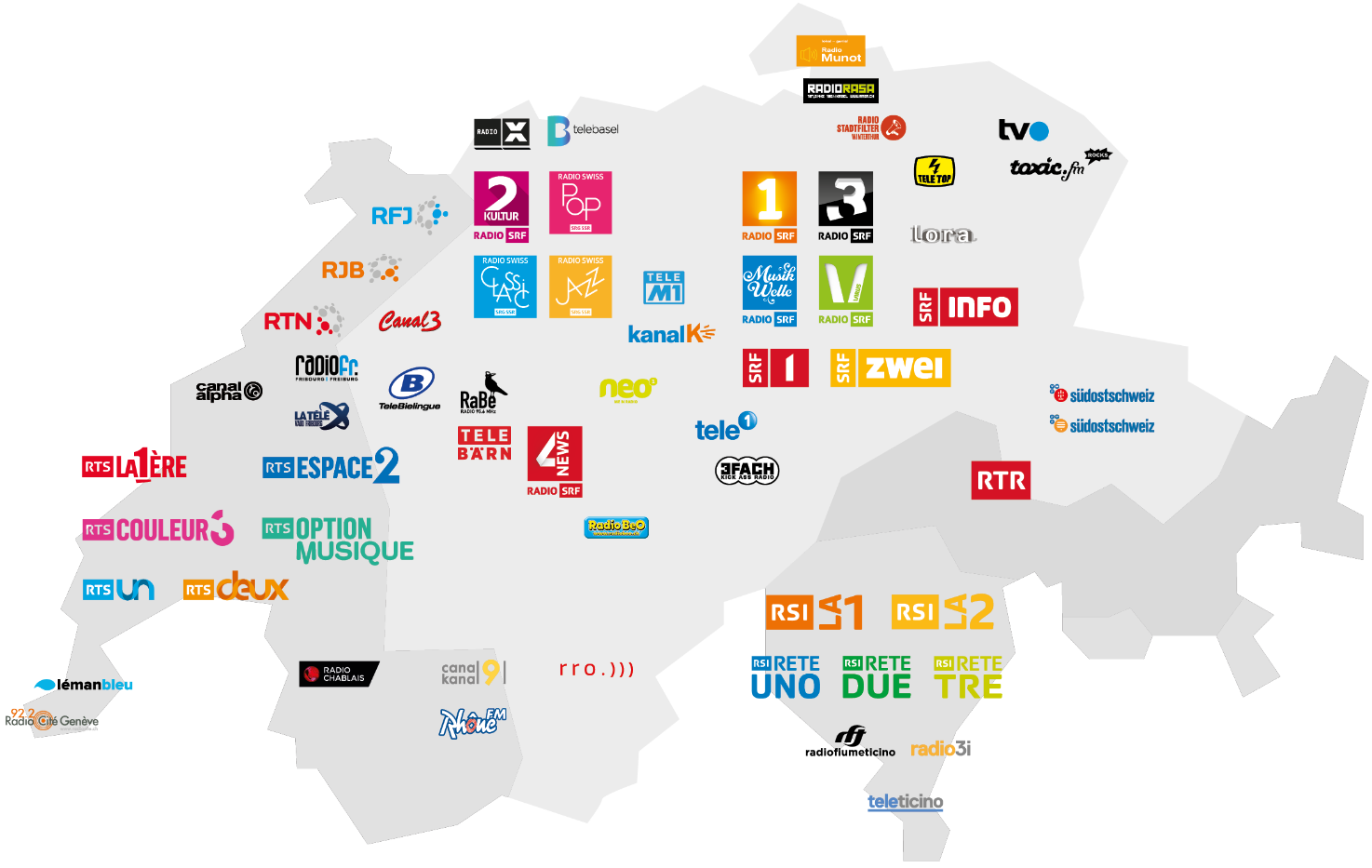
The new referendum is the second attack on the broadcasting fee after the «No-Billag» referendum that intended to eliminate the fee entirely. The referendum was rejected in March 2018 with 71,6%.
High Chance of Success
While «No-Billag» had no chance at the voting booth with its radical approach, times have changed since then. The «Halving Referendum» has significantly more potential for success for two reasons:
- Trust in journalism is at an all-time low.
- The referendum wants to reduce the fee, which is attractive to many.
In fact, a survey in October 2023 showed that 61% of participants favoured the referendum. Already in February 2022, voters rejected a package for media subsidies, which entailed the additional support of various types of outlets like digital publications.
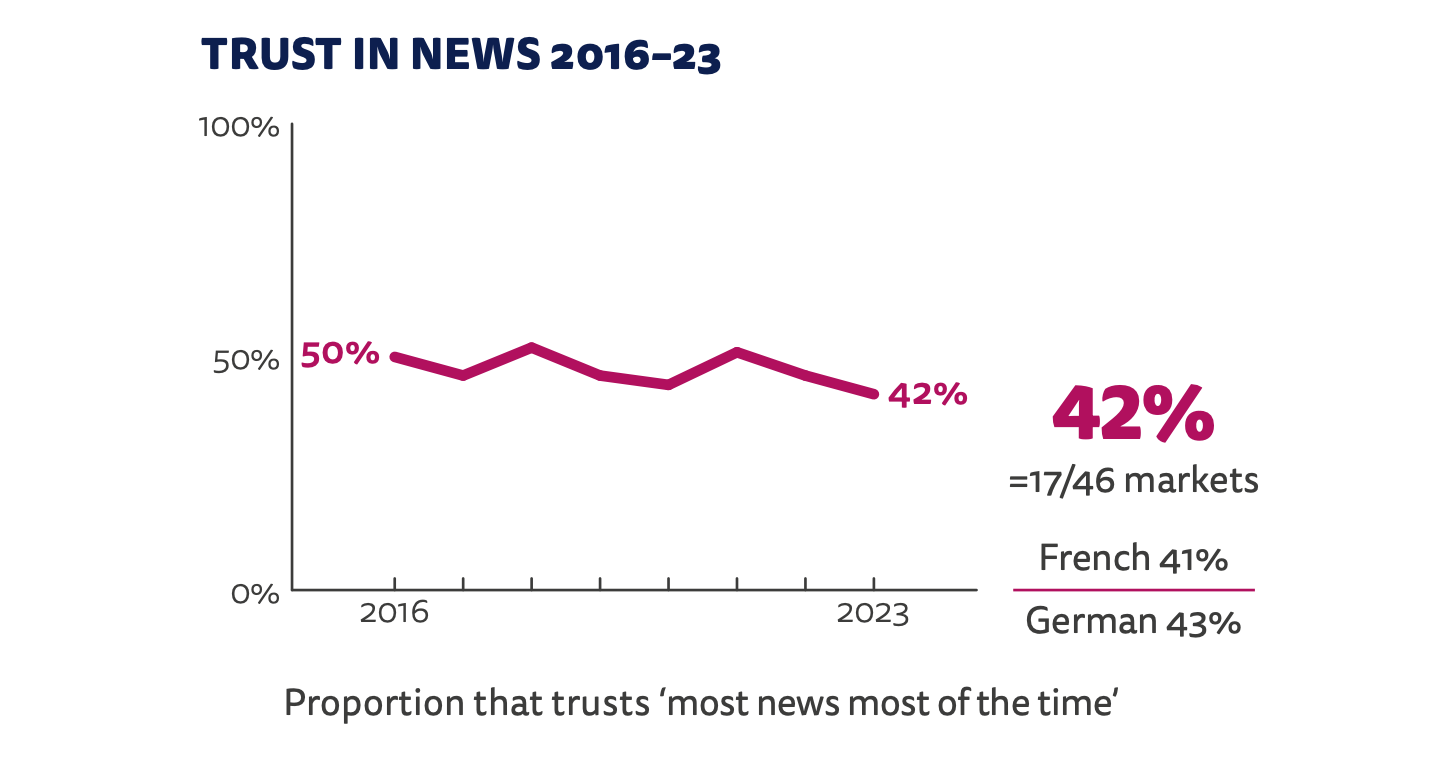
Another Far-Right Push Against Independent Journalism
It is barely surprising that most of the leading figures behind the «Halving Referendum» are part of the far-right Swiss People's Party (SVP).
As part of the committee's co-presidency, there is Hans-Ulrich Bigler, who was already leading the «No-Billag» referendum, alongside Thomas Matter, a private banking multimillionaire and second-richest member of parliament. The latter had already demonstrated his clear intentions: He used a video by the public broadcaster for his YouTube channel and cut it in a completely misleading way to promote the new referendum.
Trump Fans, Islamophobic, Convicted For Racism: The Members of The Referendum Committee
The committee has even more members with highly questionable or even racist actions in the past and present:
- Jean-Luc Addor, an SVP parliamentarian, tweeted, «We want more of that» after a shooting in a Swiss mosque where a person was killed. Switzerland's highest court sentenced him for racial discrimination. In 2013, he suggested reintroducing capital punishment.
- Franz Grütter, millionaire and SVP parliamentarian, showed great affection for Donald J. Trump, stating that «he is credible because he puts the interests of his own country back at the centre.» He was doubting that Trump would build a wall.
- David Trachsel, president of the SVP's youth party, not only threw around dictatorship accusations during the pandemic but has an affection for right-wing extremism, supports limited access to abortion and installed a whistleblowing site for allegedly «woke discrimination».
- Walter Wobmann, a former SVP parliamentarian and part of the «Egerkinger Comittee» alongside members like Niels Fiechter, convicted racist, and Anian Liebrand, convicted for defamation. The «Egerkinger Comittee» was responsible for the referendum against «facial covers» and the construction of minarets. Wobmann is also a member of the far-right organisation Pro Schweiz, formerly AUNS, which lobbied against Switzerland's entry into the UN.
Even masqueraded behind moderate and surface-level reasonable arguments, the idea behind the referendum is a further destabilisation of independent journalism. It is only one side of a long-term project by Switzerland's conservatives and far-right.
On the other side, they started to buy into the market themselves with the shady purchase of the weekly magazine «Weltwoche» in 2001, the purchase of 25 free weeklies by billionaire and SVP overlord Christoph Blocher, and the takeover of the satirical magazine «Nebelspalter» in 2020.
More Than 900 Jobs On The Line
In November, the Federal Council, Switzerland's highest executive body, presented their counterproposal to the referendum. Albert Rösti, the responsible minister and former SVP party president, suggested cutting the broadcast fee step-by-step to 300 Swiss Francs until 2029. The referendum's committee is against the proposal.
The bizarre sidenote here is that Albert Rösti is still part of the referendum's committee, although they removed him from their website. He is not allowed to leave because his name was on the signature ballots for the referendum.
Later, the SRG published a press release stating:
«With the decline in advertising revenue and the cancellation of the cost-of-living adjustment, SRG would lose up to 240 million Swiss Francs from 2027. Around 900 jobs would have to be gradually cut across all regions.»
When speaking anonymously to SRG employees, they see the 900 jobs on the line with the counterproposal as too low. «For every job lost at SRG, one is lost in the private market,» explained one journalist. Many editors, camera operators, and filmmakers are individual contractors who would also lose their engagements with the radical cuts.
The job losses would obviously be even more severe if the referendum succeeds.
Devastating Impact on Swiss Music Journalism
There is undoubtedly necessary criticism one can direct towards the SRG and its offering. Switzerland needs an informed, transparent, and sober discussion about the value of independent journalism, public service broadcasting, and the responsibility of the SRG in today's digitised media landscape.
However, the last bastion of music journalism will likely receive a big blow. Public radio already had to cut back on its high-quality music specials. Generally a niche interest, music reporting is an endangered candidate for budget cuts.
Public broadcasting and independent, often volunteer-run radio stations are the only remaining publications covering music in depth. Commercial private radios, so-called format radio stations, mostly play the most popular songs and contribute very little to the diversity of Swiss music.
Switzerland's written music journalism is dominated by non-professionals and blogs like Negative White. Prominent newspapers have chopped down their cultural reporting long ago—because, again, it remained a niche interest and seemed non-essential to the business of selling ads.
Consequences For Artists Down The Line
While written music journalism is past its peak, radio still plays a significant role for musicians as airplay generates attention and real money through royalties, generating significantly more revenue than streaming. In 2022, the Swiss royalty institution SUISA paid a record-breaking 180,5 million Swiss Francs to publishers, songwriters, and composers.
On the national level, budget cuts will potentially impact the number of available radio stations. Fewer stations—for example, abolishing the music-only station «Radio Swiss Pop»—means fewer airplay opportunities for artists and, therefore, less revenue.
According to Albert Rösti, the SRG should «focus more strongly on the areas of information, education and culture.» However, this statement is rather vague.
The SRG counters that the counterproposal will impact «co-productions of Swiss films and music recordings as well as major popular events.» Therefore, music recordings like extensive festival reporting or maybe even formats with a significant live music portion like «SRF 3 Best Talent» or the «Bounce CYPHER» could be on the line.
And if the distribution of the broadcast fee money changes, non-commercial local radios might face a life-and-death situation. Smaller indie stations like Kanal K, Radio Lora, or Radio 3FACH are essential institutions on the regional level. They are part of a fragile independent music ecosystem that provides a platform to newcomer artists and an opportunity for discovery for their listeners.
Less radio exposure also impacts an artist's concert opportunities. Airplay is already a significant factor in booking an artist for a show, with higher chances for those with airplay getting chosen.
A reduced media landscape with fewer radio stations providing this valuable asset will lead to even higher competition—and ultimately damage the Swiss indie music landscape.
Consumer Ends Up With Less
While Switzerland will not vote on the referendum before 2026, saving a couple of bucks yearly might seem attractive to a regular consumer, especially when everything gets more expensive.
However, we can see what happens with the privatisation of sports broadcasts: If you want to watch every game of the Super League, Switzerland's highest soccer tier, the yearly subscription costs 418 Swiss Francs.
While sports provide a big enough target audience for such an offer, it is unimaginable to have a similar service for, let's say, festival streams. They would rather not exist anymore—narrowing the available content overall.
With its shotgun approach, the «Halving Referendum», while targeting independent journalism, will kill a significant portion of music reporting. And take away many opportunities for Swiss musicians—especially newcomers.
Music Business Bros With An Extremely Bad Take
In 2024, Spotify will only pay artists if their song has more than 1000 streams—and some people defend it.
Last week, Threads launched in Europe, Meta's Twitter competition. Signing up with Negative White, the algorithm immediately recommended a lot of content from people in the music industry—artists, labels, promoters, managers. «Great,» I thought and read through profoundly intriguing conversations.
But then, there are so many bad takes—written mainly by men that fall somewhere between LinkedIn influencer type, crypto bro, and self-proclaimed business coach, just with a music business twist.
A trendy subject for those guys is Spotify's new policy to only pay artists for songs with more than 1000 streams. And yes, I know: By writing about it, I totally catch the engagement bait for the recognition they so desperately seek.
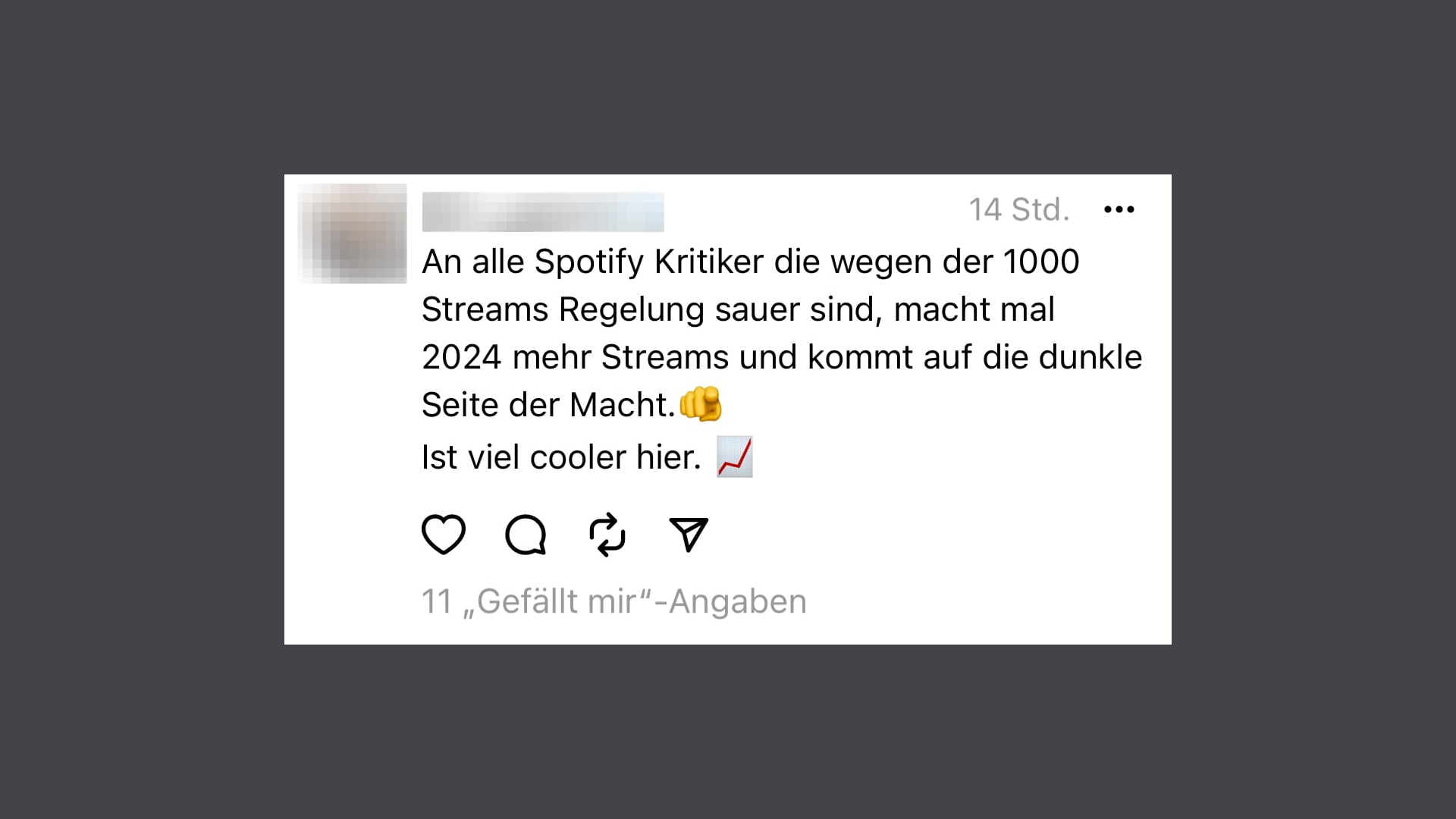
On the surface, these guys' claim that artists who can't reach 1000 streams for a song don't deserve money seems logical. Their argument that 1000 streams only equals 3 euros and doesn't do much anyway seems also solid. (Leaving aside that Spotify pays artists just horrendously bad, but let's not open this topic here.)
What these music business bros don't seem to grasp, proudly displayed in their conversations, is that the critique doesn't aim at the lost opportunity to earn these life-changing 3 euros but the crossing of a red line by one of the industry's most prominent players.

What's next? Artists only get paid if a song has 10,000 or 100,000 streams? Or if they have 10,000 monthly listeners? Or if they release a new track each month? Crossing that red line is a potential floodgate opener to all sorts of dystopian ideas not to pay the people who deliver the platform's content. That's what we should be worried about—not the number of 1000 streams itself.
And if you're still unable to understand the issue here, let me illustrate it in a different context: Imagine a concert organiser only pays artists for a gig if they sell out the venue. One ticket short? Sorry, but you don't get anything.
Again, it's not about the money: It's about a company that pays artists already horribly exerting a powerplay because its business model isn't sustainable and continues to bleed money.
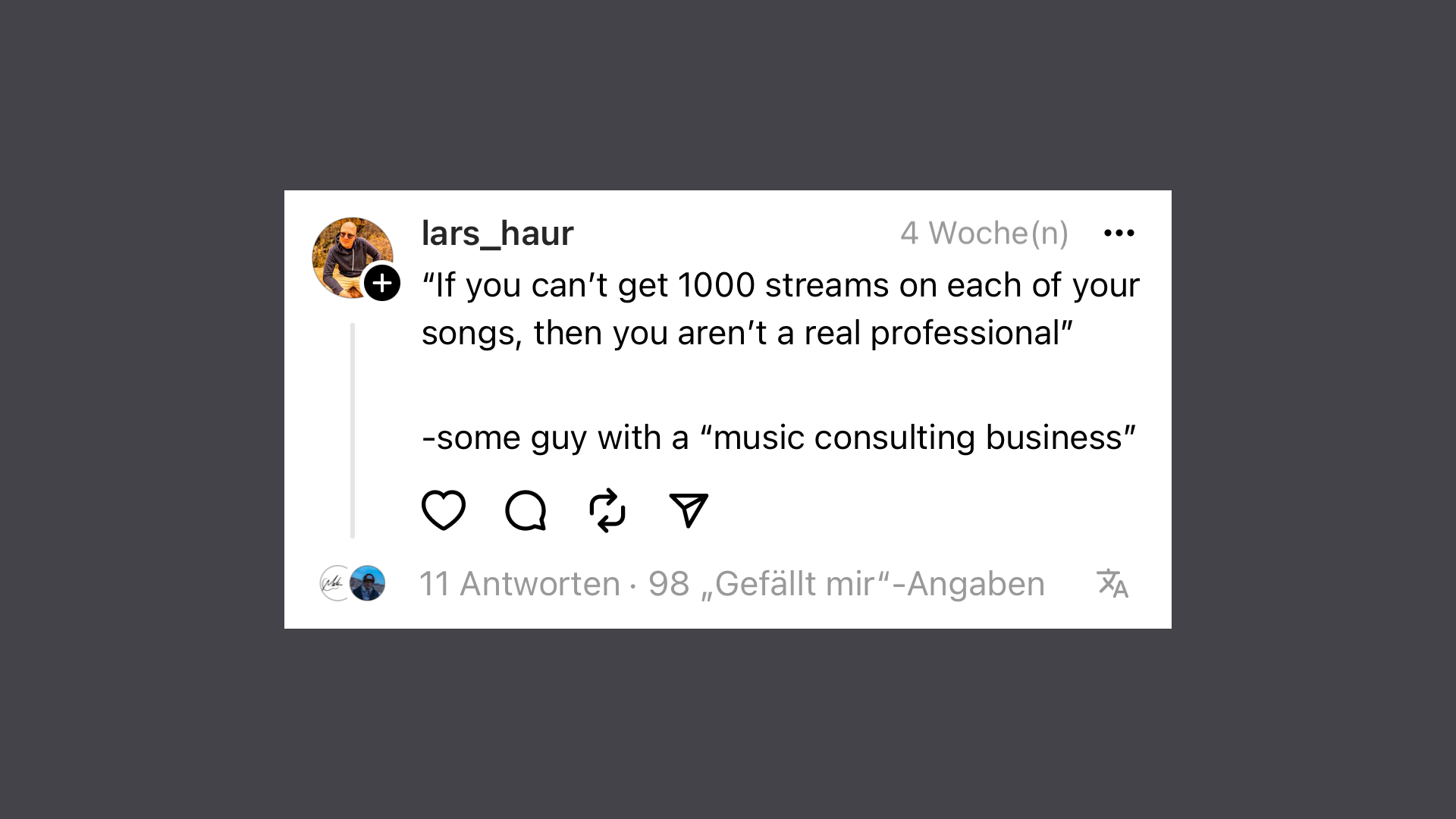
How To Best Support Your Favourite Musicians
Streaming is not a viable business for most indie artists. Here are four ways you can actually support your favourite musicians.
By now, it should hardly surprise anyone that streaming services are not a viable business model for most artists, especially if they're walking outside the big mainstream path.
While streaming platforms like Spotify or Apple Music have made it easier for consumers to access new music, the revenue model doesn't work for the majority of musicians.
Suppose you're paying a premium subscription for any of the services. In that case, the money goes into a pool—and you're financing the big labels and streaming giants like Ed Sheeran or Talyor Swift, whether you're actually listening to them or not.
While it is completely understandable not to want to ditch the convenience of streaming, every music fan should know that simply paying for a premium service does not support their favourite artists.
However, there are five easy ways alongside streaming you can use to actually (financially) support your beloved musicians and enable them to keep doing what they do best.
Buy Their Music
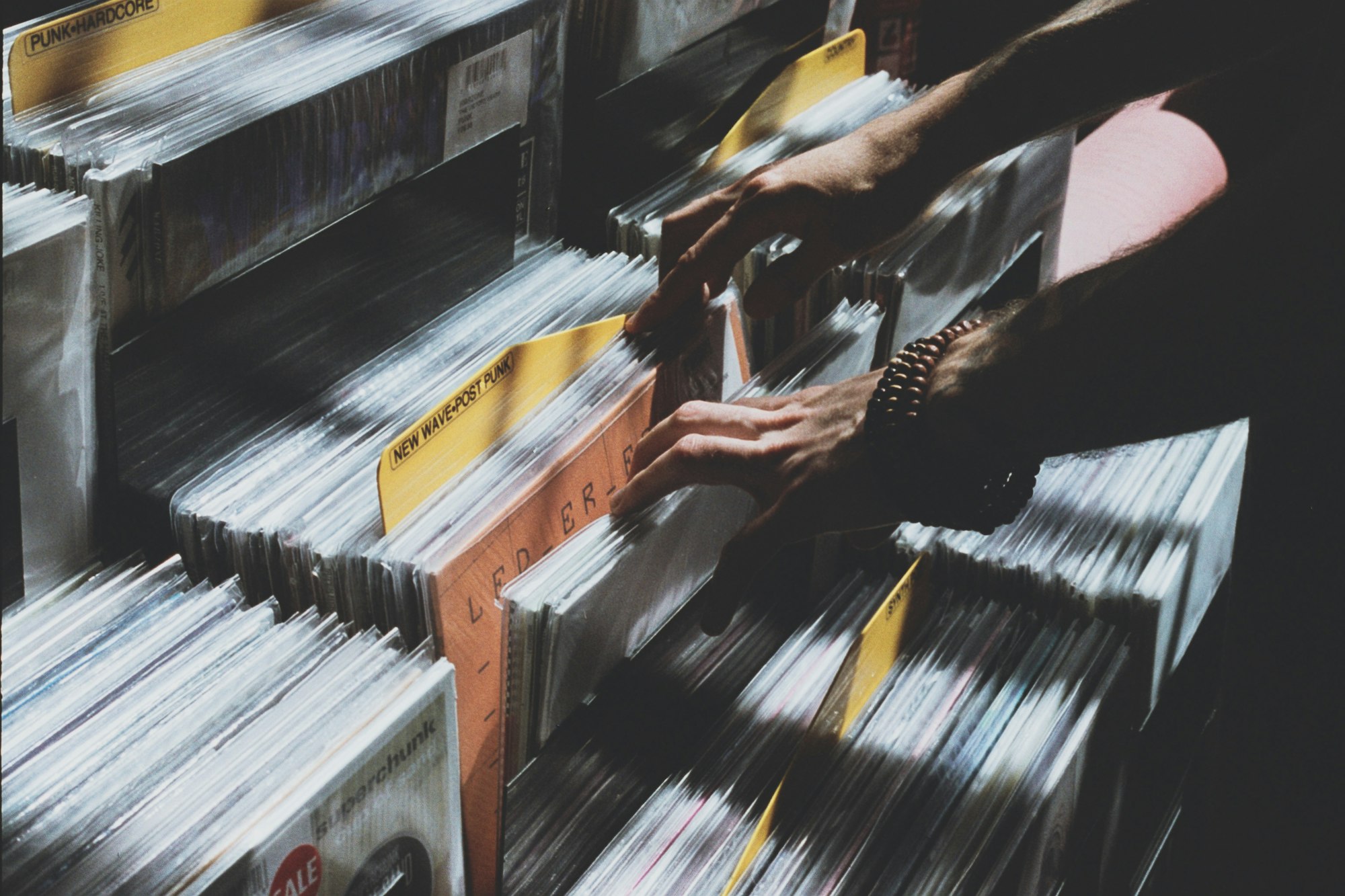
Okay, this should be obvious: Buying is better than streaming. When you buy an album or single physically or digitally, the artists get a fixed amount of money.
There are even two main advantages for you as the buyer: If you purchase a physical product like a vinyl record, you have a piece of art to decorate your home (provided the cover art is outstanding).
And if you buy a digital download, the music is protected, and you actually own a copy of the file. Streaming services often remove songs from their platforms, or the artists themselves delete them for various reasons.
Buy Tickets Early

Concerts are great to support your favourite musicians. They not only earn money from ticket sales but shows provide an easy opportunity for them to sell merchandise (see next point).
However, since the pandemic, pre-sales have been struggling, sometimes even leading to cancelled shows because the financial risk was too high.
So if you really want to see your favourite artist live, buy a ticket early. And keep this also in mind: You're simultaneously supporting your local concert venue. What a great feeling!
Buy Their Merchandise
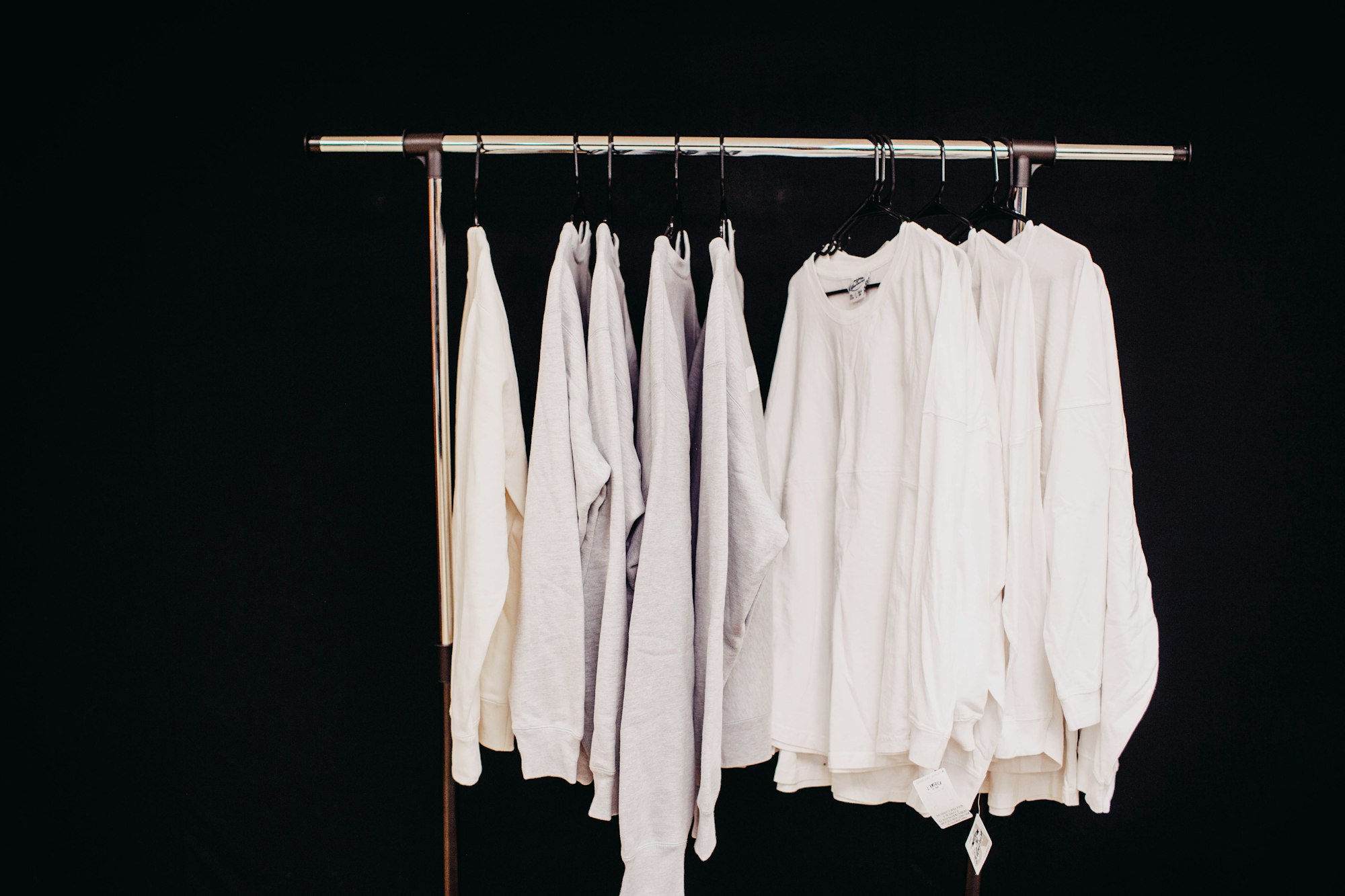
As mentioned above, merchandise aside from physical music has become an essential revenue stream for artists. While certain genres like metal have engrained it into their culture with band shirts and patches, it isn't as common in other scenes.
So purchasing merchandise like shirts, stickers, or other bits and pieces is an effective way to help artists make ends meet—especially because compared to the music itself, there are fewer stakeholders like labels, publishers, or distributors involved.
Support Them On Creator Platforms
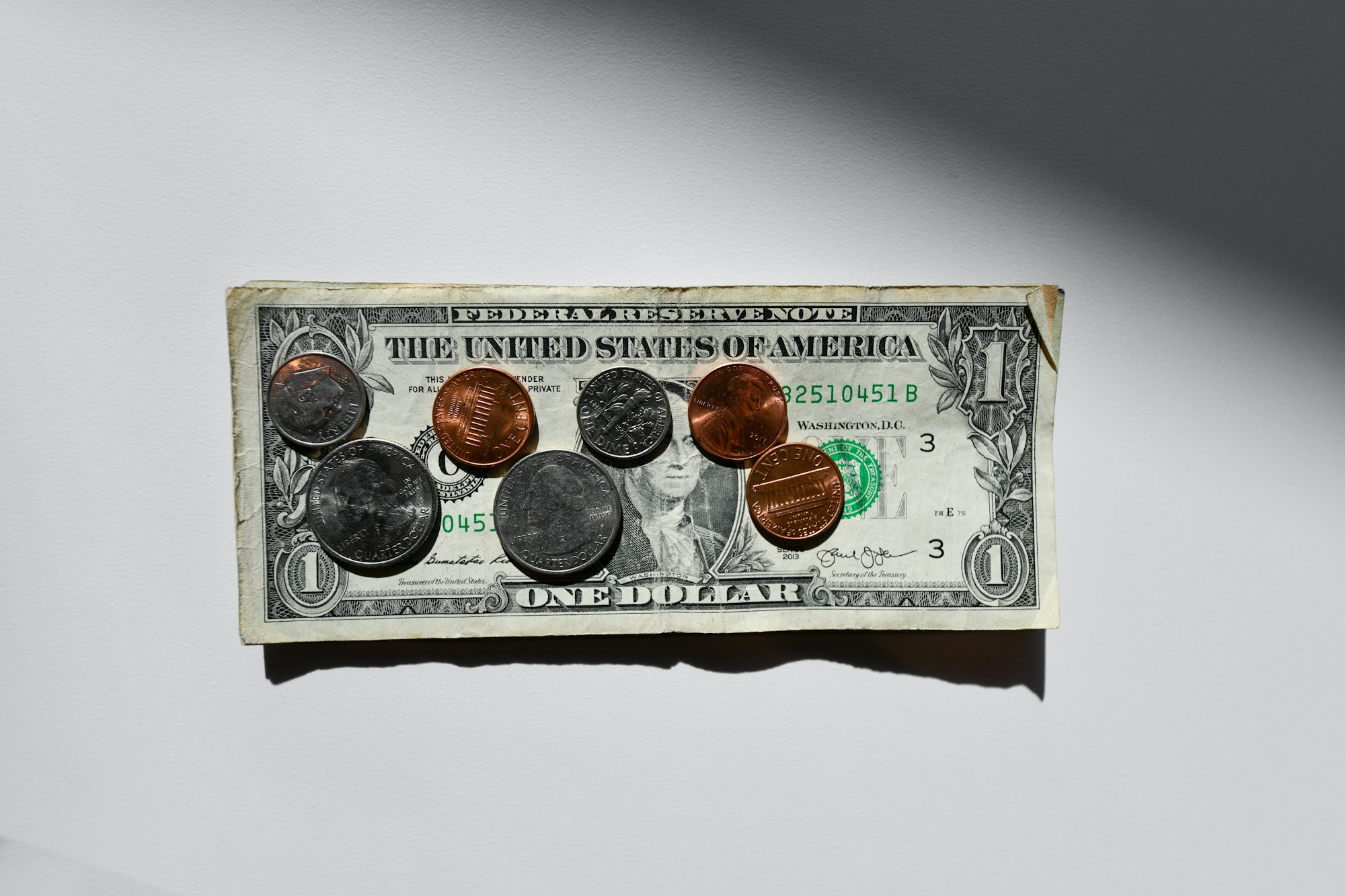
Some musicians take advantage of newer opportunities to gain the support of their fans. They might be present on creator platforms like Patreon or Fanklub, where you pay a small monthly subscription. These platforms provide them with a steady income, often trading the money for exclusive content for their paying supporters.
Other artists seek funding for their next album on a crowdfunding platform. Also, there, you can directly support the musicians in their creative endeavours.
Spread The Word

Well aware that all of these support approaches require a certain disposable income in a time when life, in general, gets more expensive, it's also worth considering that the same is true for musicians.
It is important to remember that music, despite all the contrary signs, is not just a commodity but art created with passion and inspiration. It brings us relief, channels emotions, and sparks joy.
However, there's one thing that helps and is completely free: Spread the word! Recommend artists to your friends and multiply their reach through social media.
